9 Assortment Planning
The Assortment Planning offers the depth and breadth of Assortments for retailers for a given season leveraging AI foundation services to get forecast, assortment recommendations and optimized KPIs to meet the organizational goals. The first half of the Assortment Planning task is the preparation to go to market and make the key decisions on the number of options to carry with the needed attribute mix. The high-level Assortment Planning process flow includes reviewing historical information, Forecast Targets and reconciling with MFP targets, setting plan parameters, Determine # of Options, defining the assortment, creating new options, Planning Buy Quantity for the Assorted Items the assortment goals, and finally, approving the assortment (Shopping list).
Typical Business Users
The typical business user who completes this task will be an Assortment Planner.
Data Requirements
-
Last Year Sales/Forecast Sales data
-
Current plan data from MFP
-
Location hierarchy
-
Product hierarchy
-
Calendar hierarchy
-
Sales Retail, Sales Unit, and Cost actuals
-
Style/Color (Item/Option) attributes and attribute values
-
Style/Color (Item/Option) images loaded by the Administrator (optional)
-
Fixture information entered by the Administrator
Create the Assortment Planning Segment
When working in a segment, it is a common practice to keep the wizard selections for the segment size limited to what will be worked on, to facilitate navigation and increase UI responsiveness.
To create the Assortment Strategy segment:
-
Click Assortment Services in the Task menu. Then, click the Planning Services activity and then the Assortment Planning task.
-
The dialog to create New Plan opens. Click Create New Plan.
-
Enter the Plan Label into the text field. Click Ok.
-
In Select Product, select one department and click Next.
-
In Select Assortment Period, select any one assortment period and click Next:
-
The Assortment Groups visible in the wizard are pre-ranged to the subcategories selected in the previous screen.
-
To see the user-defined Assortment Period label, click the Dimension tile and select Assortment Label.
-
The store clusters have also been assigned to each assortment period while creating assortment periods. The user can directly jump into the workspace after making the product and season selections.
Note:
Assortment Labels can vary by Sub-class. If multiple subcategories are selected, the label shown will be based on the first order Sub-class.
Click Finish. The Create Assortment segment is built.
-
Assortment Planning Process Steps
The high-level steps to complete this process:
-
Perform Last Year / Forecast Analysis of Sales, Gross Margin, Option Count, and Rate of Sales.
-
Determine the Target number of Options.
-
Create New Options.
-
Run Demand Transference to get AI Foundation backed recommendations on the right Assortments to choose
-
Optimize key KPIs leveraging Demand Transference Optimization engine
-
Select the Options into the shopping list.
-
Reconcile key KPIs against Forecast/MFP Targets
-
Plan Buy Quantity
-
Approve the plan.
Step 1: Review History/Forecast/Target Analysis
The first step in the Create Assortment process is Review History/Plan analysis. The planner can analyze the Last Year Sales, Gross Margin, Option Count, Average Unit Retail, and Rate of Sales along with the plan targets. This information is intended to provide a complete picture of what needs to be accomplished by this assortment and what has been accomplished by prior assortments, both in terms of sales profitability and in terms of key trends and attributes that define each assortment. The planner can review the point of commerce plan/plan by each channel and reconcile with MFP targets/Forecast Sales Targets. This step is helpful in setting targets in the next step.
Tabs and Views in this Step:
Review Last Year Tab
In this tab, the Senior Buyer/Planner can review the Last Year historical sales data by product and product attribute. The data would be analyzed to view the trends and how the sales spread across attributes.
Review LY History View
This view focuses on the sales and profitability history of the prior year for the same time period by Style/Color (or higher) and Cluster (or higher). Here in the default profile, the sales are split into Full price (Reg+Promo) and Clearance Sale. An additional profile, Gross Margin, is used to calculate total sales and Gross Margin based on the Total cost and Retail price. This Gross Margin can be one of the Targets while running the automation processes of Wedge building. Assortment Strategy will continue to use only the full price sales data as the planner cannot intentionally plan assortments for clearance sales.
The step to complete this process:
-
Analyze the last year values.
Figure 9-1 Review LY History View
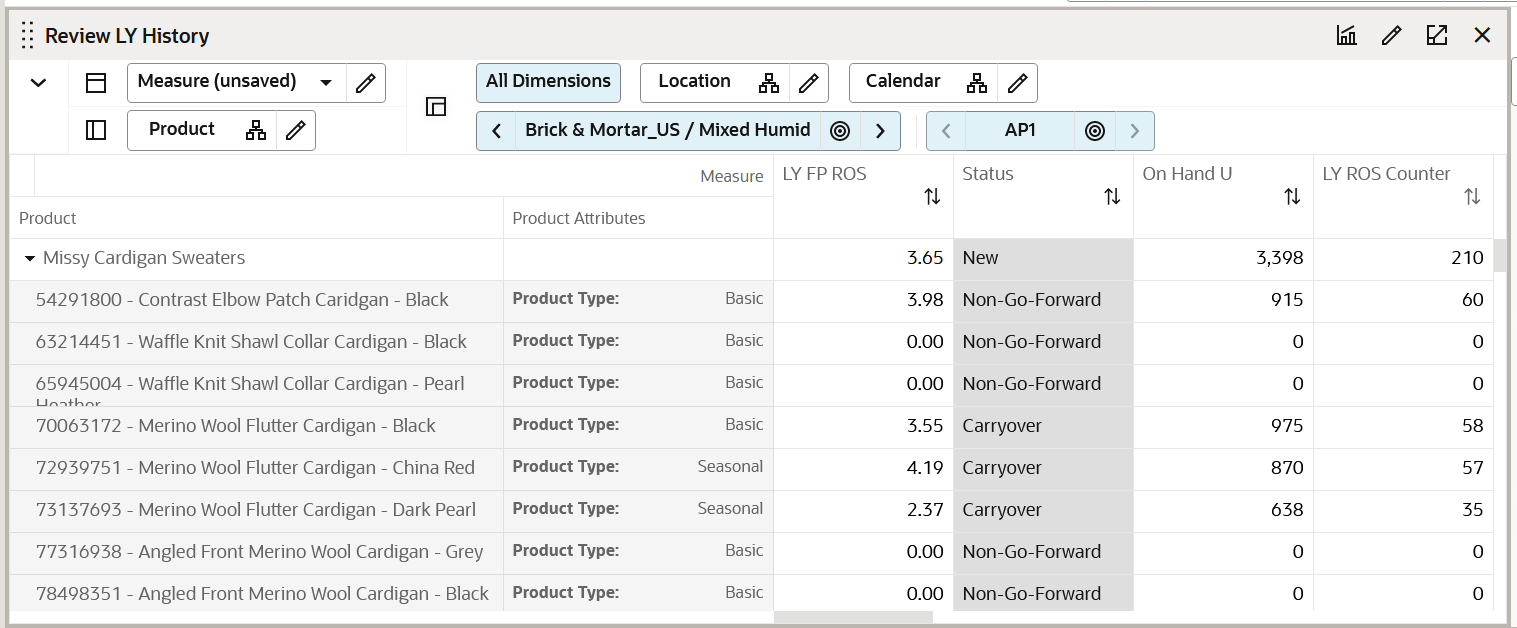
Measure Table
Table 9-1 Review LY History View Measures
| Label | Definition |
|---|---|
|
LY Sales R, U, AUR |
Last Year Total Sales Retail, Units, and Average Unit Retail. |
|
LY Markdown R, R% |
Last Year Markdown Retail and Retail Percentage. |
|
LY GM R |
Last Year Gross Margin Retail. |
|
LY GM R % |
Last Year Gross Margin percentage. |
|
LY Option Count |
Count of Options carried Last Year. |
|
LY ROS |
Last Year weekly Rate of Sales. |
|
% to LY Sales U, R |
The Percentage of Sales Unit Retail of the option to all the options considered in the Last Year. |
|
Rank by LY Sales U |
Rank of the option by considering Last Year Sales Units. |
|
LY Sell Thru % |
The Last Year Sell Through percentage of the option. |
|
Rank by LY Sell Thru % |
Rank of the Option by considering Last Year Sell through percentage. |
|
LY Reg+Promo R, U, AUR |
Last Year Full Price Retail, Units, and Average Unit Retail. |
|
Status |
Auto-generated status of the option selected. |
|
Status Override |
Ability provided for the planner to override the auto-generated status per the business needs. |
|
On Hand U |
On Hand Inventory Units. |
|
Location Count |
Count of Locations assigned to each Store Cluster. |
|
Assort Period Week Count |
Number of Weeks in the Assortment Period. |
|
LY BOP U |
Last Year Beginning of Period Units. |
|
LY Location Count |
Count of Locations assigned to each Store Cluster Last Year. |
Review MFP Tab
In this tab, the Senior Buyer/Planner can review the Merchandise Financial Plan by Subclass.
Review MFP Targets View
The Senior Buyer is able to view the planned sales (from the Merchandise Financial and/or Location Plan) and profitability for the time periods covered at the intersection of Subclass (or higher), Assortment Period, and Cluster (or higher) level. In the Administrative section, the Merchandise Financial Plan and Location Plans (or LP) are spread down to the Subclass, Week, and Cluster levels (if they were not created originally at this level).
The default profile shows the Full price (Reg+Promo) Sales. An additional profile, Gross Margin, is used to calculate total sales and Gross Margin based on the Total cost and Retail price. This Gross Margin can be one of the Targets while running the automation processes of Wedge building. Assortment Strategy will continue to use only the full price sales data as the planner cannot intentionally plan assortments for clearance sales.
Figure 9-2 Review MFP Targets View
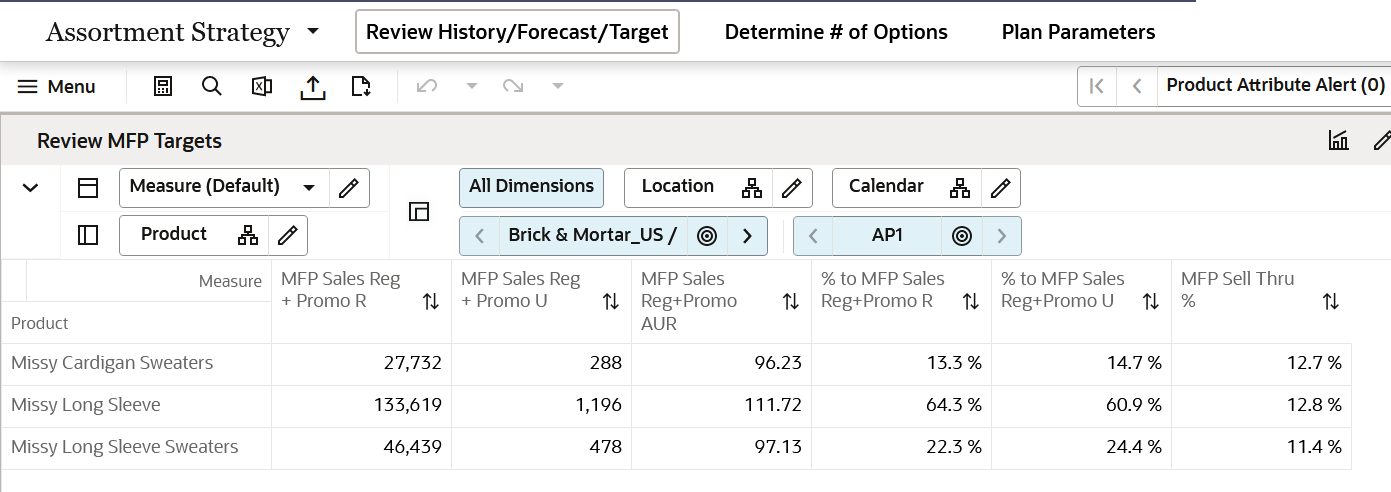
Measure Table
Table 9-2 Review MFP Targets View Measures
| Label | Definition |
|---|---|
|
MFP Sales R, U, AUR, AUC |
MFP Current Plan Total Sales Retail, Units, Average Unit Retail, and Average Unit Cost by Sub-class, store, and week. |
|
% to MFP Sales R, U |
The percentage of MFP Sales Retails, Units of the specified Sub-class to the sales of all the subcategories. |
|
MFP GM R |
MFP Current Plan Gross Margin Retail. |
|
MFP GM R % |
MFP Current Plan Gross Margin Retail Percentage. |
|
MFP Sales Reg+Promo R, U, AUR |
MFP Current Plan Full Price Sales Retail, Units, and Average Unit Retail by Sub-class, store, and week. |
|
MFP Sell Thru % |
Sell through percentage of the Sub-class by the current plan of MFP. |
|
Location Count |
Count of Locations assigned to each Store Cluster. |
|
Assort Period Week Count |
Number of Weeks in the Assortment Period. |
|
MFP Receipts U |
MFP Current Plan Receipts Units. |
Measure Profiles
Default Profile
This profile is used to access the view which focuses on the MFP Current Plan.
Gross Margin
The Gross Margin profile is used to view the Gross Margin numbers of the MFP Current Plan.
Review Forecast Tab
Review Forecast View
In this tab, the Senior Buyer/Planner can review the Forecast by Subclass.
The Senior Buyer is able to view the Forecasted sales recommendation by AI Foundation Services and profitability for the time periods covered at the intersection of Subclass (or higher), Assortment Period, and Cluster (or higher) level. In the Administrative section, the Forecast from AI foundation services are loaded at Subclass, Week, and Cluster levels.
Figure 9-3 Review Forecast View

Measure Table
Table 9-3 Review Forecast View Measures
| Label | Definition |
|---|---|
|
Fcst Sales Reg+Promo C, AUC |
Forecast Reg + Promo Cost, Average Unit Cost by Sub-class, store, and week. |
|
% to FC Sales R, U |
The percentage of Forecast Sales Retails, Units of the specified Sub-class to the sales of all the subcategories. |
|
Fcst Sales Reg+Promo R, U, AUR |
Forecast Sales + Promotional Retail, Units, and Average Unit Retail by Sub-class, store, and week. |
Measure Profile
Default Profile
This profile is used to access the view which focuses on the MFP Current Plan.
Plan Parameters Tab
In this tab, the Senior Buyer/Planner is able to include the minimum threshold sales unit, receipts unit and/or carryover min stock to consider the style/color as a carryover item.
Depending on the threshold units defined by the planner for carryover min stock, the item status changes according to Carryover or Non-Go Forward status of Seasonal items. Items can be categorized as Basic/Seasonal items by specifying the corresponding attribute of product type. For all Basic items, Carryover status is derived from the combination of item lifecycle end date and on-hand units at the beginning of the assortment period.
The sales and receipt unit thresholds defined will be used in the ROS calculation. Only if the number of units is beyond the minimum threshold defined for Sales U and Receipts U, ROS will be calculated.
Define Forecast Retail/Cost View
AI Foundation services generates and recommends Forecast units. This view allows the Administrator to define the source to copy the AUR and AUC from for the products. If the Administrator selects MFP as the source, AUR and AUC are copied from MFP for the products having forecast units. If the Administrator selects LY as the source, AUR and AUC are copied from History for the products having forecast recommendations. Using the AUR and AUC values copied from source and the Forecast Units recommended by AI foundation services, system will determine the Forecast Retail and Forecast Cost for the given subclass.
The step to complete this process:
-
Define thresholds for minimum Sales Units, Receipts Units, and Carryover Units.
Measure Table
Table 9-4 Define Forecast Retail/Cost View Measures
| Label | Definition |
|---|---|
|
Forecast Retail/Cost |
Drop-down list measure to determine the source to copy AUR and AUC from. MFP and LY are the two available sources. |
Measure Profile
Default Profile
This profile is used to access the view which focuses on defining the thresholds.
Define Thresholds View
This view focuses on removing special/one off buys to optimize the history used for target option calculations. The planner can create the parameters around historical data used to calculate the Target Number of options.
The step to complete this process:
-
Define thresholds for minimum Sales Units, Receipts Units, and Carryover Units.
Figure 9-4 Define Thresholds View
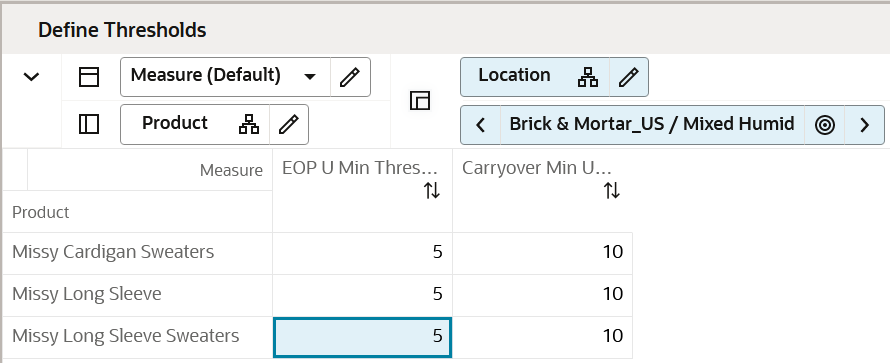
Measure Table
Table 9-5 Define Thresholds View Measures
| Label | Definition |
|---|---|
|
EOP U Min Threshold |
Minimum EOP Units threshold to consider the options into the Rate of Sales Calculation that is defined at Sub-class or higher levels. |
|
Carryover Min Units Threshold |
Minimum on hand Units threshold to consider the options as Carryover status. |
Measure Profile
Default Profile
This profile is used to access the view which focuses on defining the thresholds.
Define Product Rollup View
The Define Product Rollup view is used to select product attributes to view in an alternate hierarchy. This is available in the tab to display the item level. Nested product attribute roll up is provided with three levels. A planner can set up to three different combinations for nested rollup with a maximum of three levels in each combination. Nesting of dynamic attributes is a configurable option.
For example: As a first combination, you select Brand as a Level 1, Color as Level 2, and Fabric as Level 3 by clicking the list of attributes available at that category.
This allows you to roll up your items by brand, then color inside each brand and then by fabric inside each color. This feature also allows you to view subtotals for each of the levels. You can edit subtotals and spread the values to all the associated child positions.
The planner can analyze, review, and edit the proposed assortment based on important attributes. You may select up to three attributes at a time for the dynamic rollup.
The steps to complete this process:
-
Select up to three dynamic product attributes from the drop-down list.
-
Run the Refresh Product Rollup Application Action.
-
To view the product attribute:
-
In a view that displays item level, click the Product Hierarchy tile.
-
Select the attribute (Attribute 1 or 2 or 3) that you would like to view in the nested dynamic rollup.
-
Click OK.
-
Figure 9-5 Define Product Rollup View
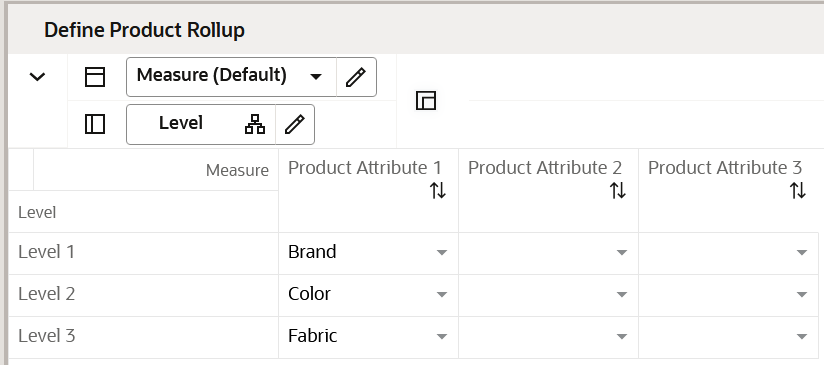
Figure 9-6 Edit View
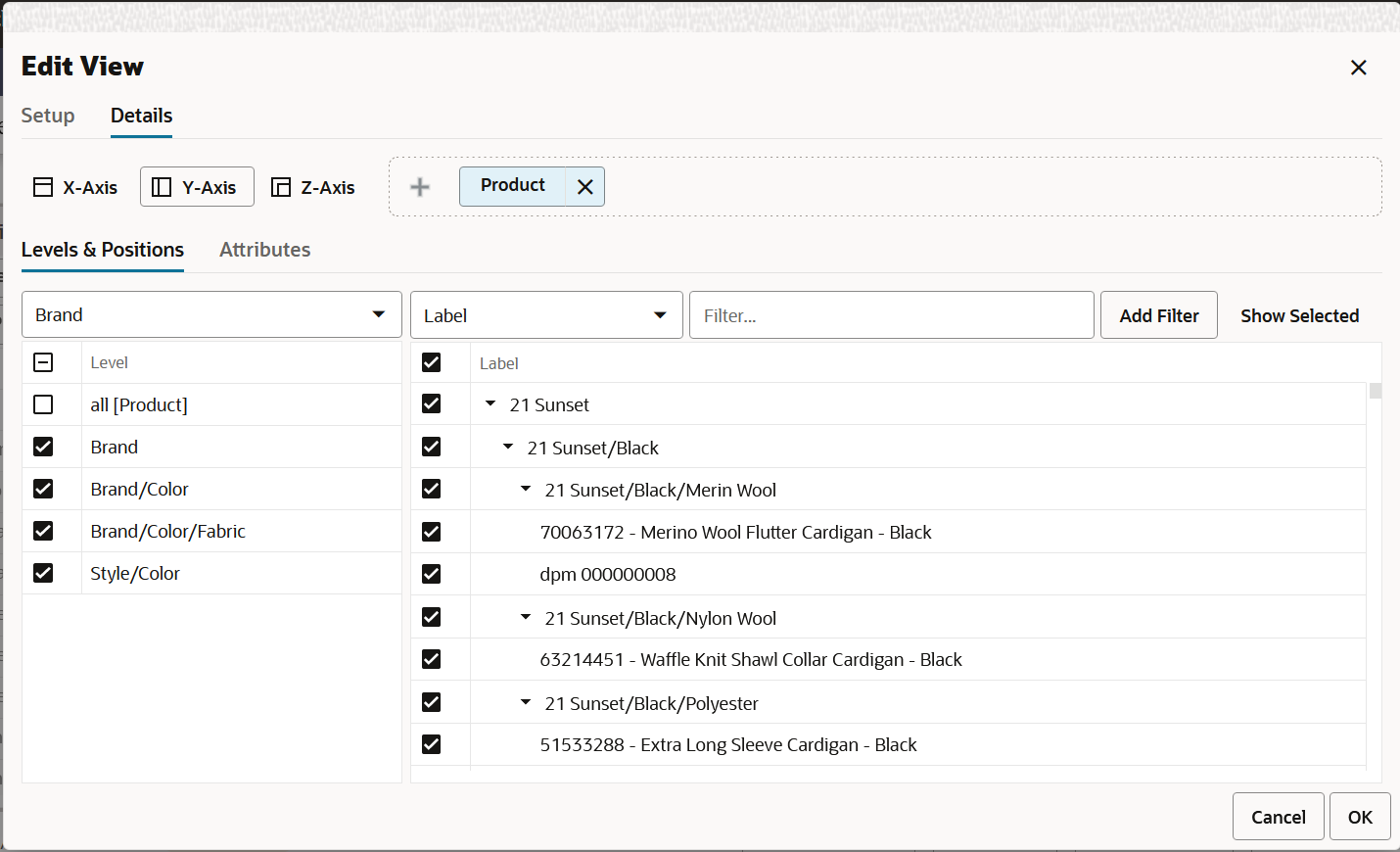
On selecting the alternate dynamic hierarchy defined in the product rollup window in the views, you can see the subtotals at each nested level. For all the editable measures, You can edit these subtotals to spread the values to all the associated positions.
Figure 9-7 Subtotals
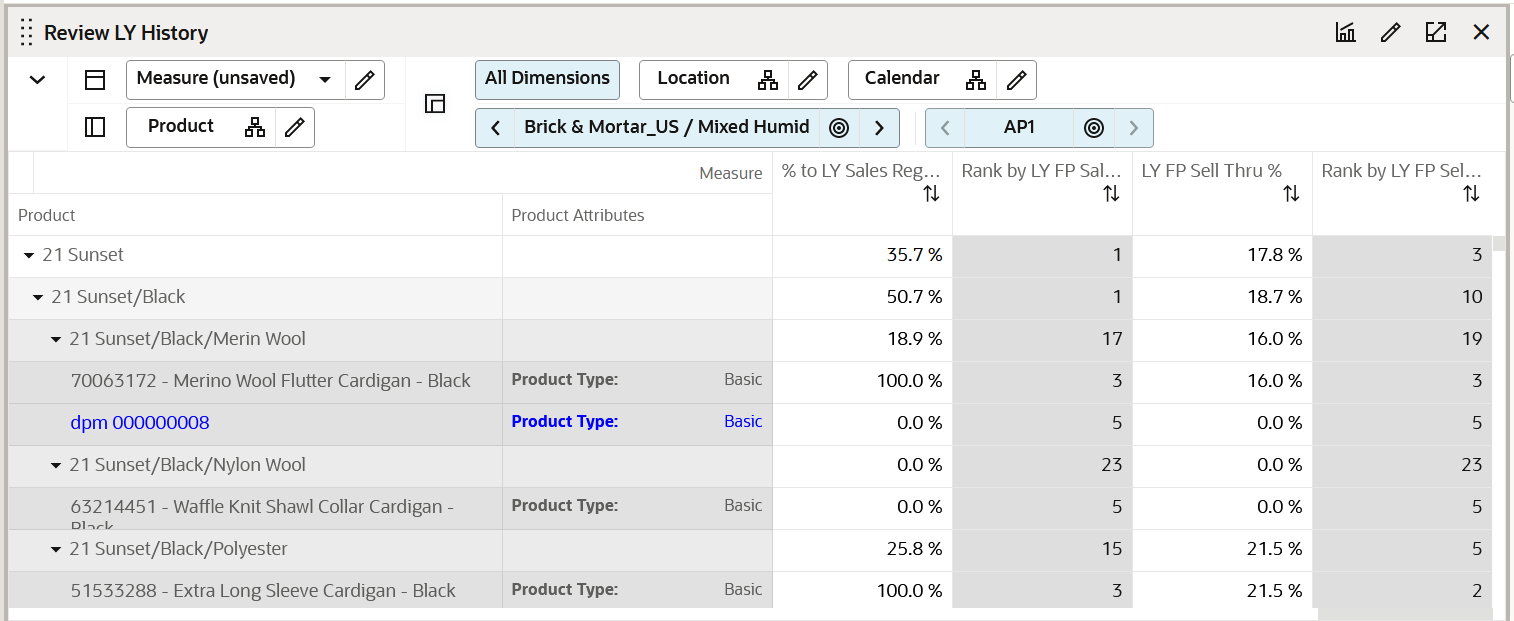
Measure Table
Table 9-6 Define Product Rollup View Measure
| Label | Definition |
|---|---|
|
Product Attribute 1, 2, 3 |
Drop-down list to present product attributes for nested dynamic product hierarchy rollup. |
Measure Profile
Default Profile
The Default profile is used to select dynamic product attributes. The planner can view up to three Levels to review and work on Plans rolled up to multiple attributes. Using the nested dynamic product rollup feature, the planner can group plans for three different attributes. If a planner is working on a class and if level 1 is brand, level 2 is color, and level 3 is fabric, the planner can review and analyze plans for all brands of a class, then across all colors inside each brand and then across every fabric for each color. For all the editable measures, planner can even edit these subtotals visible across each level to spread the plans to lower positions.
Application Action
Refresh Product Rollup
The Refresh Product Rollup Application Action creates dynamically updated alternate hierarchies based on user-defined attribute selections. After running the application action, the user may select the alternate product hierarchy to see plans grouped based on the attribute selections.
LY Standard Deviation View
This view focuses on providing the history of the sales deviation of each store in variance to the average. Deviations act as a decision point to decide what a store assortment should look like. Deviations are simply the variance to a mean. This will help the planner to plan a tighter assortment for stores selling less than the average and a larger assortment for stores selling better than the average.
The step to complete this process:
-
Analyze the last year deviation of the stores.
Figure 9-8 LY Standard Deviation View
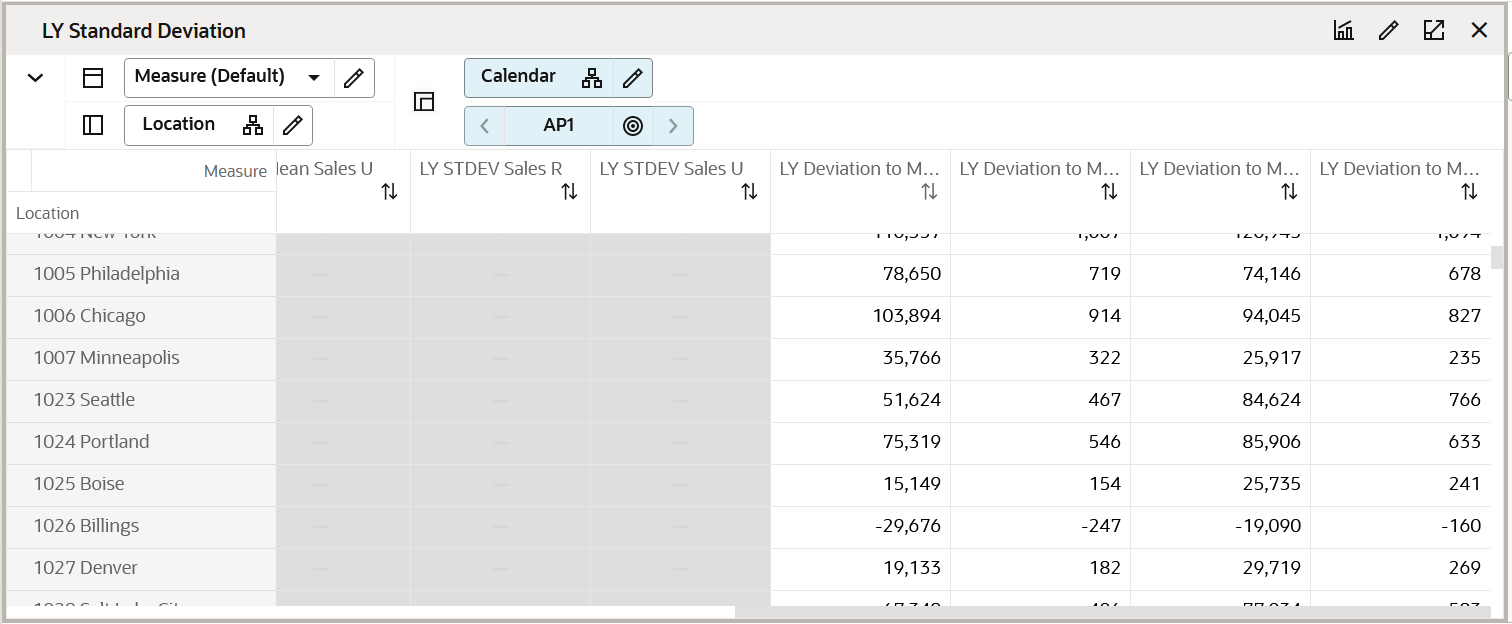
Measure Table
Table 9-7 LY Standard Deviation View Measure
| Label | Definition |
|---|---|
|
LY Sales Reg + Promo R |
Last Year Full Price Sales Retail value sold in each store. |
|
LY Sales Reg + Promo U |
Last Year Full Price Sales Units sold in each store. |
|
LY Mean Sales R |
Last Year Average of Sales Retail across all selected stores visible at cluster and higher cluster level only. |
|
LY Mean Sales U |
Last Year Average of Sales Units across all selected stores visible at cluster and higher cluster level only. |
|
LY STDDEV Sales R |
Last Year Standard Deviation of Sales Retail calculated at cluster and higher levels. |
|
LY STDDEV Sales U |
Last Year Standard Deviation of Sales Units calculated at cluster and higher levels. |
|
LY Deviation to Mean Sales @ Cluster R |
Last Year Deviation of Sales R of Store from the mean at Cluster level and higher. |
|
LY Deviation to Mean Sales @Cluster U |
Last Year Deviation of Sales U of Store from the mean at Cluster level and higher. |
|
LY Deviation to Mean Sales @ Channel R |
Last Year Deviation of Sales R of Store from the mean at Channel level and higher. |
|
LY Deviation to Mean Sales @ Channel U |
Last Year Deviation of Sales U of Store from the mean at Channel level and higher. |
Measure Profile
Default Profile
The Default profile is used to select dynamic product attributes. The planner can view up to three Levels to review and work on Plans rolled up to multiple attributes. Using the nested dynamic product rollup feature, the planner can group plans for three different attributes. If a planner is working on a class and if level 1 is brand, level 2 is color, and level 3 is fabric, the planner can review and analyze plans for all brands of a class, then across all colors inside each brand and then across every fabric for each color. For all the editable measures, planner can even edit these subtotals visible across each level to spread the plans to lower positions.
Application Action
Refresh Product Rollup
The Refresh Product Rollup Application Action creates dynamically updated alternate hierarchies based on user-defined attribute selections. After running the application action, the user may select the alternate product hierarchy to see plans grouped based on the attribute selections.
Review Attribute Weights View
This view shows the weights of different product attributes determined by AI Foundation services. Also, attributes are ranked based on their individual weights. This information is provided to guide the user on what attributes to emphasize of while arriving at the assortment plans.
Figure 9-9 Review Attribute Weights View
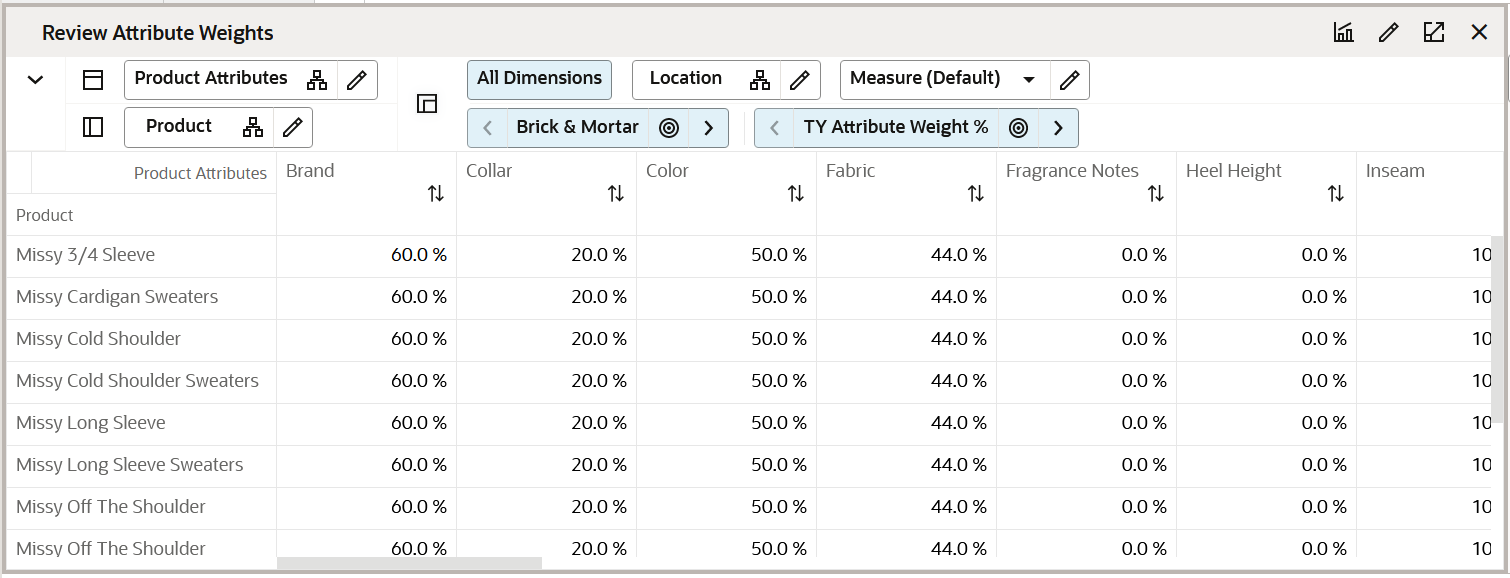
Measure Table
Table 9-8 Review Attribute Weights View Measures
| Label | Definition |
|---|---|
|
Attribute Weight % |
This measure shows the % weight of the attribute. The higher the attribute weight, the better are the assortments. |
|
Attribute Weight Rank |
Rank of each item attribute based on the attribute weight. |
Step 2: Determine Number of Options
The second step in the Assortment Planning process is to determine the number of options. The planner can seed the last year, Forecast, or MFP targets, or set the values manually for Sales, Gross Margin, Rate of Sales, New Options, and Total Options enabling the planner to determine the targeted number of options for the assortment.
Views in this Step:
Application Action
Seed Sales
The Seed Sales Application Action is used to seed last year, Forecast, or MFP sales data in the Determine # of Options view.
Determine # of Options View
The Determine # (number) of Options View is used to determine the target options, Sales, Gross Margin, Rate Of Sales, markdowns, total options, and new options for each sub-category (or higher level of the product hierarchy). The planner can seed the targets based on Last Year, Forecast, or MFP values. The planner can also override the seeded values of Sales, Gross Margin, Rate of Sales, and Total/new Options. The number of options is determined for the Full Price (Reg+Promo) only.
The steps to complete this process:
-
Select Last Year, Forecast, or MFP from drop-down menu of the Seed measure.
-
Run the Seed Sales Application Action.
Figure 9-10 Determine # of Options View
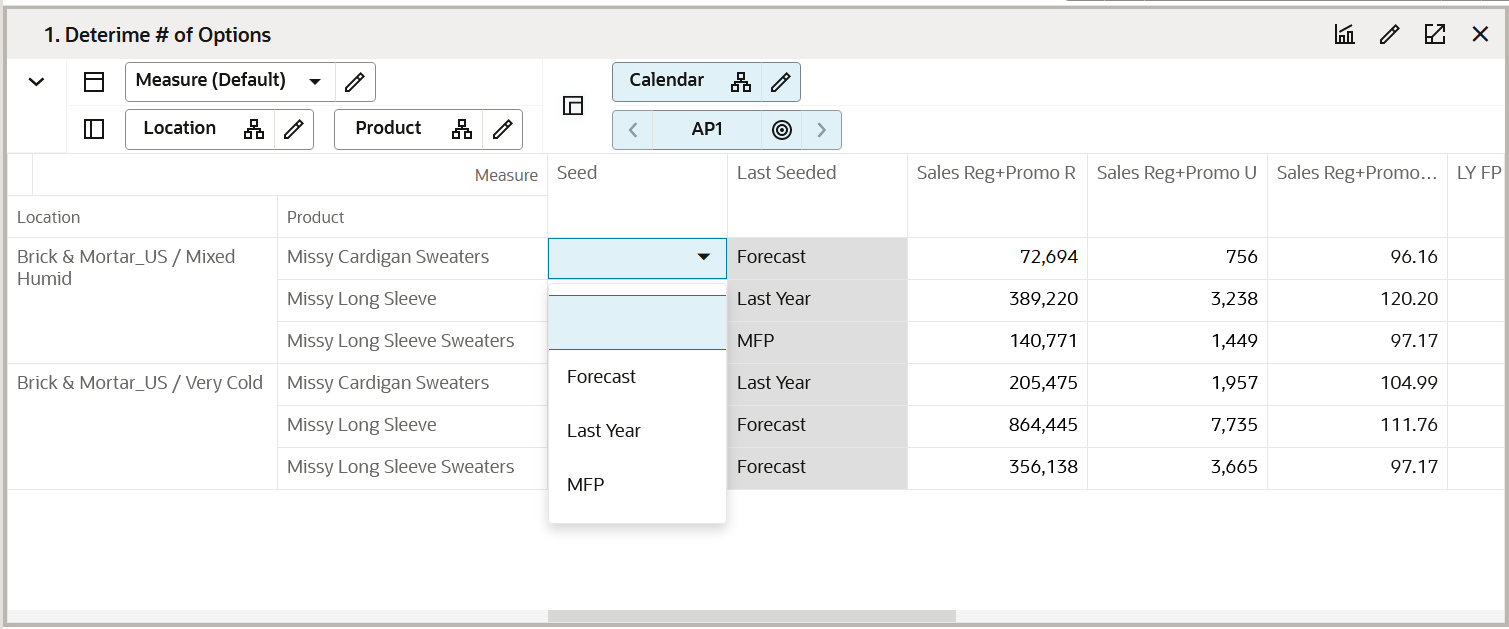
Measure Table
Table 9-9 Determine # of Options View Measures
| Label | Definition |
|---|---|
|
Seed |
Used to select seed from Last Year, Last Season, or MFP. |
|
Last Seeded |
Shows the seeding option selected previously for the plan. |
|
Sales Reg+Promo R, U, C, AUR, AUC |
Working Plan Full Price Sales Retail, Units, Cost, Average Unit Retail, and Average Unit Cost. |
|
GM R |
Gross Margin Retail. |
|
GM R % |
Gross Margin Retail percentage. |
|
Sales R, U, C Var LA% |
Total Sales Retail, Units, and Cost variance comparing to Last Assortment. |
|
LY FP ROS |
Last Year Full Price ROS. |
|
FP ROS |
Working Plan Full Price ROS. |
|
WP FP Ttl Options |
Working Plan Full Price Total Options. |
|
New Options |
Number of New Options in each cluster. |
|
New Options % |
Percentage of New options in each cluster. |
|
Carryover Options |
Number of Carryover Options in each cluster. |
|
Sales R, U, C Var LY% |
Total Sales Retail, Units, and Cost variance comparing to Last Year. |
|
GM R Var LY% |
Gross Margin Retail Variance comparing to Last Year. |
|
GM R Var MFP CP% |
Gross Margin Retail Variance comparing to MFP Current Plan. |
|
LY Sales R, U, C, AUR, AUC |
Last Year Sales Retail, Units, Cost, Average Unit Retail, and Average Unit Cost. |
|
LY Sales Reg+Promo R, U, C, AUR |
Last Year Full Price Sales Retail, Units, Cost, Average Unit Retail, and Average Unit Cost. |
|
LY GMR |
Last Year Gross Margin Retail. |
|
LY GMR% |
Last Year Gross Margin percentage. |
|
Sales R, U, C Var MFP Tgt% |
Sales Retail, Units, and Cost variance comparing to the Current Plan from MFP. |
|
GM R Var MFP Tgt % |
Gross Margin Retail Variance comparing to the Current Plan from MFP. |
|
MFP Sales R, U, C, AUR, AUC |
Current Plan from MFP Total Sales Retail, Units, Cost, Average Unit Retail, and Average Unit Cost. |
|
MFP GM R |
Gross Margin Retail from Current Plan of MFP. |
|
MFP GM R% |
Gross Margin percentage from Current Plan of MFP. |
|
MFP Sales Reg+Promo C, R, AUR, U |
Full Price Sales Cost, Retail, Units, and Average Unit Retail from Current Plan of MFP. |
|
New Options % |
The New Options % drives how much of the assortment is carryover and how much is new for the planned assortment period. |
|
New Options |
Count of options which are new in the planned assortment period. |
|
Carryover Options |
Count of options which are calculated based on the Carryover status. |
Measure Profiles
Default Profile
This profile is used to access the view which focuses on the Working Plan.
Last Year Profile
This profile is used to access the view that can be used when using Last Year as the basis for setting targets.
Forecast
The Forecast profile is used to access the view that can be used when using Forecast as the basis for setting targets.
MFP Profile
This profile is used to access the view that can be used when using plans imported from Merchandise Financial Planning as the basis for setting targets.
Application Action
Seed Sales
The Seed Sales Application Action is used to seed from Last Year, Last Assortment, or MFP sales data in the Determine # of Options view.
Status Override
This view is used to override the status of a style color if required while determining the number of options and the percentage of New versus Carry Over options. This will enable the planner to make any quick status changes if required to arrive at the final # of options and the % of New versus Carryover items. The steps to complete this process:
-
Review the status of style color.
-
Override the status of style color to New or Carryover based on the business requirement. Click on calculate and review the New Vs Carryover % in the assortment.
Figure 9-11 Status Override View
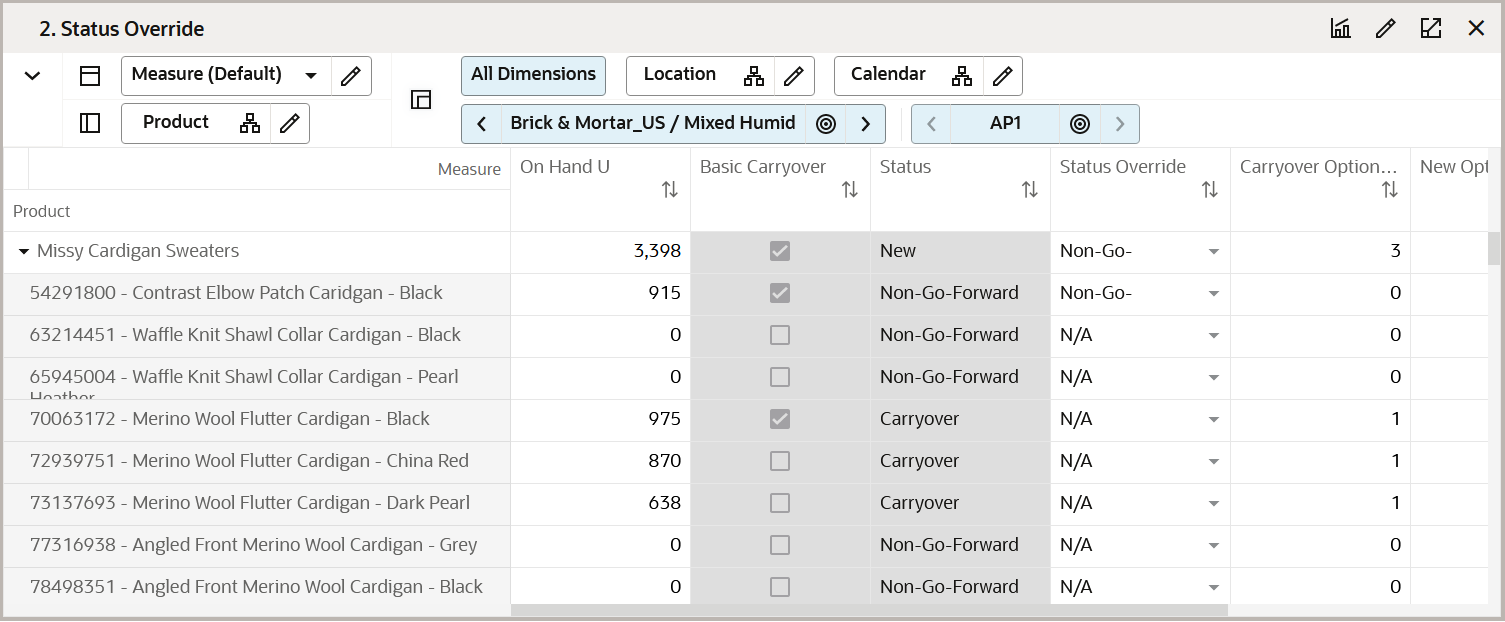
Measure Table
Table 9-10 Status Override View Measures
| Label | Definition |
|---|---|
|
On-Hand U |
On Hand Units for a given style color. |
|
Basic Carryover |
Boolean measure to highlight an item as an item with the product type of Basic and having a carryover status because of on-hand and item end date. |
|
Status |
Final status of the item. |
|
Status Override |
Editable drop-down list to choose the item status from to override the current status. |
|
WP FP Ttl Options |
Total Number of Full Price options. |
|
New Options |
Total number of New options. |
|
New Options % |
Percentage of New options. |
|
Carryover Options |
Total number of carryover options. |
Create Options View
The Create Options view is used to decide the items for which new options must be created and, using placeholder maintenance, you can create/modify/delete the new options as needed.The steps to complete this process:
-
Decide the new options (items) to be created.
-
Use Placeholder Maintenance to create/modify/delete the new options (items).
-
Use the like Item option by selecting the existing Items from the list of values.
-
Determine the start and end week of all the options (New and Carryover) to specify the selling weeks/flow within a given season.
-
Mark the item as Mandatory if the option is to be considered as a must-have option in the final Assortment.
-
Modify Retail Price, Cost, and/or Initial Markup % (IMU %).
-
Assign the size range values from the list (should have been loaded by the administrator).
Figure 9-12 Create Options View
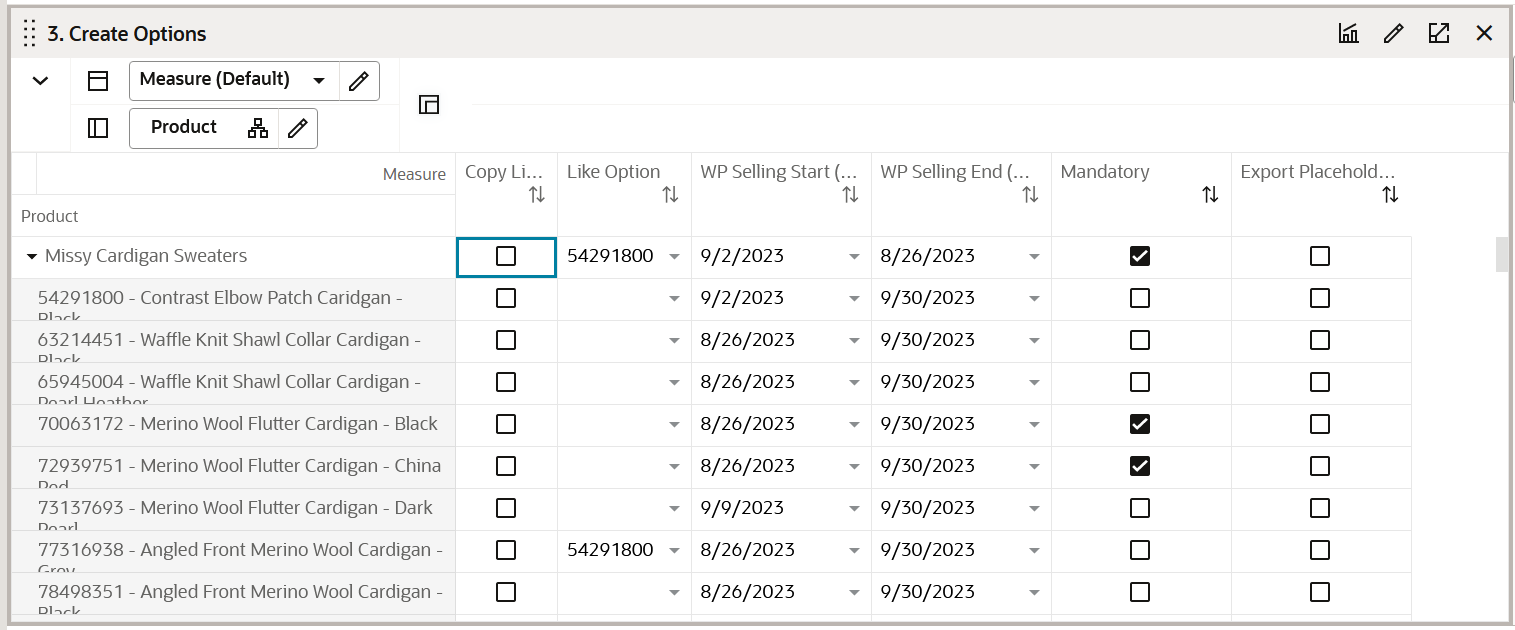
Measure Table
Table 9-11 Create Options View Measures
| Label | Definition |
|---|---|
|
Like Option |
An already existing item option used to populate the product attributes and/or Sales R, U, and GM R measure data to the newly created placeholder position. |
|
WP Selling Start Week(Override) |
Wp Selling Start week is the beginning of selling cycle for the option. If this is not overridden, the first week of the season is considered as the item selling start week. |
|
Wp Selling End Week(Override) |
Wp Selling End week is the last week of selling cycle for the option. If this is not overridden, the last week of the season is considered as the item selling end week. |
|
Mandatory |
Option is marked as a mandatory option if the option is a must-have in the final assortment. |
|
Export Placeholder to RMS |
Boolean check box to select if the newly created placeholder position should be exported to RMS or not. |
Measure Profiles
Default Profile
The Default profile is used to create new placeholder positions, assign any like item as needed, and adjust Base unit retail price and cost. The buyer can also associate the size ranges to the options, and can also make a choice if the placeholder position created should be exported to the Merchandising system or not.
Enhanced DPM/Place Holder Maintenance
The Create Options view is DPM-enabled and can be used to create new positions with utmost ease. The import DPMs from Excel feature can create bulk placeholders with minimum effort. For more information on DPM/placeholder maintenance, see the Oracle Retail Predictive Application Server Cloud Edition User Guide.
Assign Attributes View
The Assign Attributes view is used to assign attributes to the new placeholder items. You can select/override the attribute values for the placeholder items created and for already existing items. An additional attribute called product type allows the planner to categorize style-colors as Basics or seasonal lines. Basics are all the merchandise that runs through the year irrespective of the season, such as White T-shirts, socks, Denims, Hand keys, and so on. Most retailers have a consistent and a predictable demand for these basic lines. Seasonal style colors are all those items that last a particular season, such as sweaters for winter, cotton clothes for summer, and so on. The product type attribute allows the planner to plan basics across multiple seasons in one go in Item Planning - Basic which allows the planner to focus more on seasonal items that are short life cycle products.
While the Buyer is allowed to make changes to an existing item's attributes in this view, those changes will not be sent back to a master data management (MDM) system such as Oracle Retail Merchandising System (RMS), which is the system of record for product attribute information. If a change is made to an existing item here, it will need to be communicated back to the source system. This view validates and highlights any attributes that are unassigned and brings them to the planner's attention.
The step to complete this process:
-
For placeholder items, assign the appropriate attribute values.
-
Set the attribute values for the newly created placeholder items that are unassigned with values for the required attributes.
Figure 9-13 Assign Attributes View
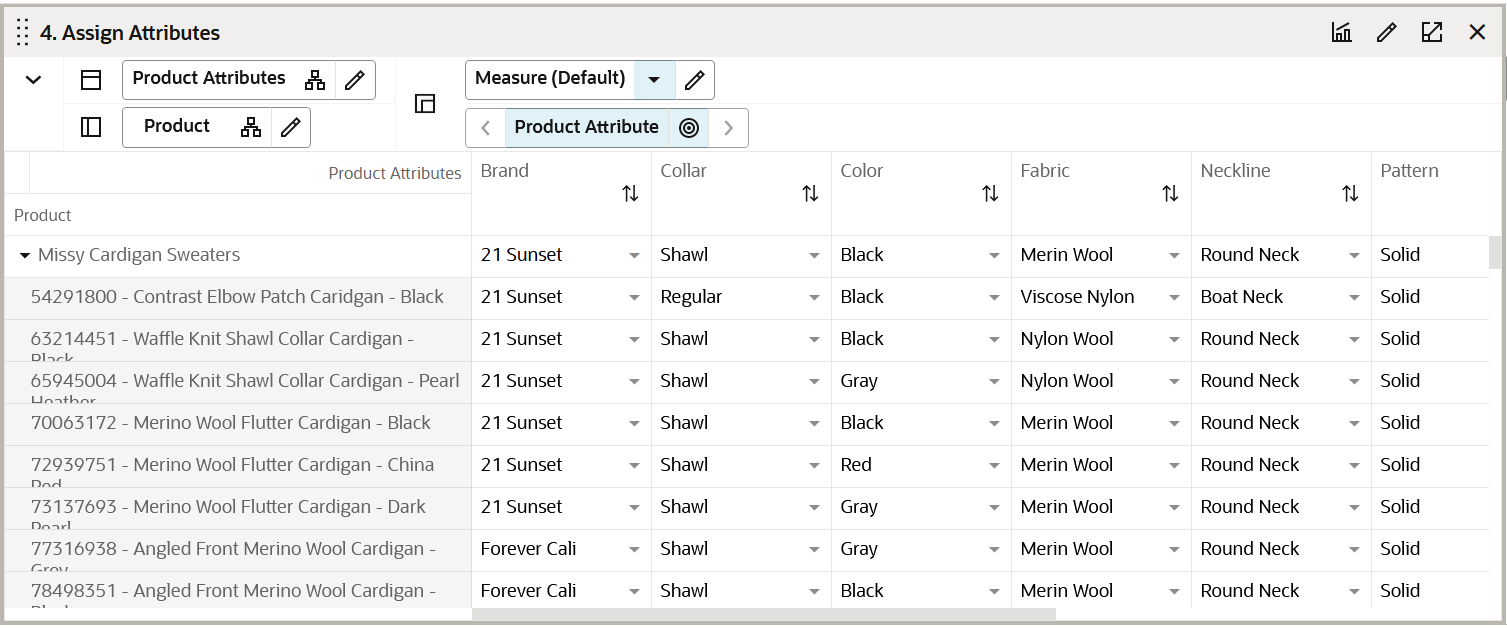
Measure Table
Table 9-12 Assign Attributes View Measure
| Label | Definition |
|---|---|
|
Edit Attribute Value |
Drop-down list measure that enables the mapping/overriding of item attribute values to an item. |
|
Export Placeholder to RMS |
Boolean flag to select to export the placeholder information to RMS. |
Measure Profile
Default Profile
The Default profile is used to assign/override the product attribute values for the items.
Define Retail Price/Cost View
This view contains the loaded Retail Price and Cost Price for each Style-Color. The planner also has the ability to override the loaded Retail or Cost Price. This information is later used in the planning process in Item Planning.
Figure 9-14 Define Retail Price/Cost View
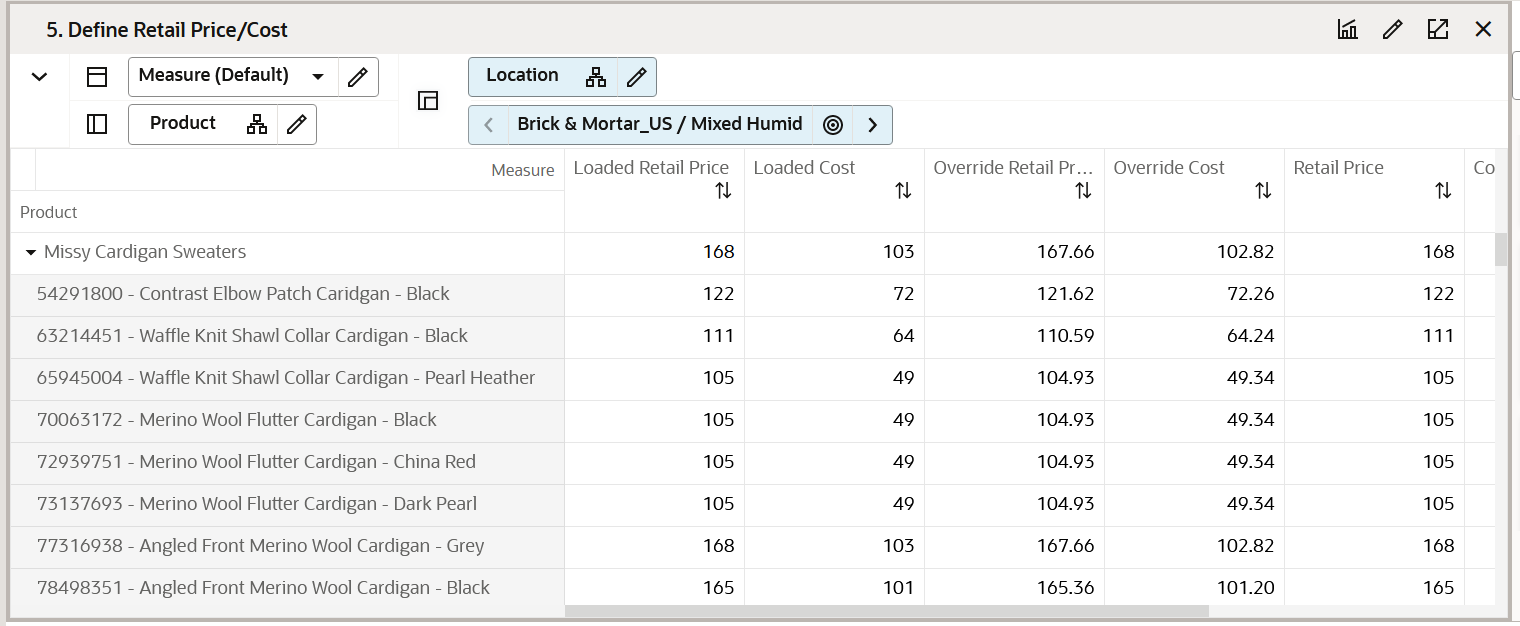
Measure Table
Table 9-13 Define Retail Price/Cost View Measures
| Label | Definition |
|---|---|
|
Retail Price |
An item's base retail value. |
|
Cost |
An item's base cost value. |
|
Loaded Retail Price |
Retail Price of the item loaded from external system |
|
Loaded Cost |
Cost of the item loaded from external system |
|
Retail Price (Override) |
Retail Price of the item Overridden by the planner |
|
Cost(Override) |
Cost of the item Overridden by the pla |
Step 3: Plan Assortment
Plan Assortment step allows the planner to create Assortment leveraging AI foundations infused recommendations. Demand Transference Optimization Engine further optimizes the specific KPIs chosen by the planner to meet the financial goals. Demand Transference also helps planner to Add, drop or swap options based on various parameters helping the retain the best profitable Assortments for the chosen selling cycle.
Views in this Step:
Assortment Recommendation Parameters View
This view allows the planner to set the parameters to recommend Assortments. The lowest level recommendations are set are at the cluster/sub-class level. Planner can choose various targets to meet from the available drop-down list. The values available are target options, MFP Target, Forecast or Strategy Plan. If planner chooses the target options, the Assortment options are recommended to meet the target options set in the Determine # of options step. If MFP Targets are selected, Assortments are recommended to meet the MFP Targets. Similarly if Forecast is selected as the parameter, Assortment options are recommended to meet the Subclass level Forecast Targets. If the planner chooses Strategy plan as the option, user can specify the KPI that needs to be matched to meet a specific business objective. Planner can choose the recommended option as Strategy plan and Metric for Assortment Recommendation as Sales U, in this case, the built-in AI Foundation recommends assortments to meet Sales U planned previously.
The system is intelligently built to consider the status of mandatory options, carry over options, Rate of Sale, item similarity score, attribute weights of the item etc to arrive at the best possible Assortment recommendation.
Figure 9-15 Assortment Recommendation Parameters View
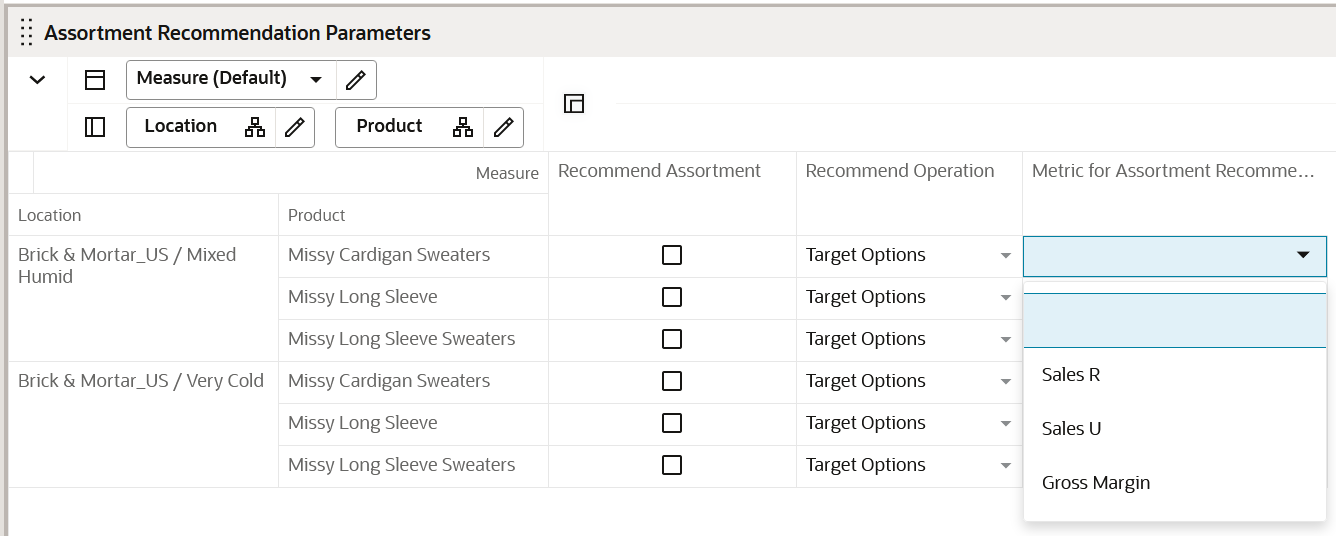
Measure Table
Table 9-14 Assortment Recommendation Parameters View Measures
| Label | Definition |
|---|---|
|
Recommend Assortment |
Measure to select the subclasses/cluster combination to be considered for the assortment recommendation |
|
Recommend Operation |
Drop-down list measure to choose from Target options, MFP Target, Forecast and Strategy Plan |
|
Metric for Assortment Recommendation |
If the Recommend operation is selected as Strategy plan, planner should specify one of the metrics to meet to get the best possible assortment recommendations |
Measure Profile
Default Profile
The Default profile is used to select Assortment Recommendation Parameters.
Recommend Assortment
Recommend Assortment application action recommends the best performing assortments based on the parameters set by the planner. The Application Action considers the status of mandatory options, carry over options, Rate of Sale, item similarity score, attribute weights of the item etc to arrive at the best possible Assortment recommendation.
Create Assortment View
Create Assortment view enables the planner to review the assortment recommendations provided by the built-in AI Foundation engine. This view also allows the planner to override the AI Foundation recommendations and make manual changes if required. This view provides a comprehensive set of all key metrics required to make assortment decisions. This view contains key information such as Recommended Rate of Sale, Target number of options and the assorted total number of options, New Versus carryover % of items, The beginning and end of Selling weeks, total selling weeks and so on. Planner can review all the information and make edits any if required to address a business use case. Once assortments are created here, planner can review the assortment depth and the time phased assortment plan in the subsequent views to ensure assortments are planned well and spread well across various weeks in a season.
Figure 9-16 Create Assortment View
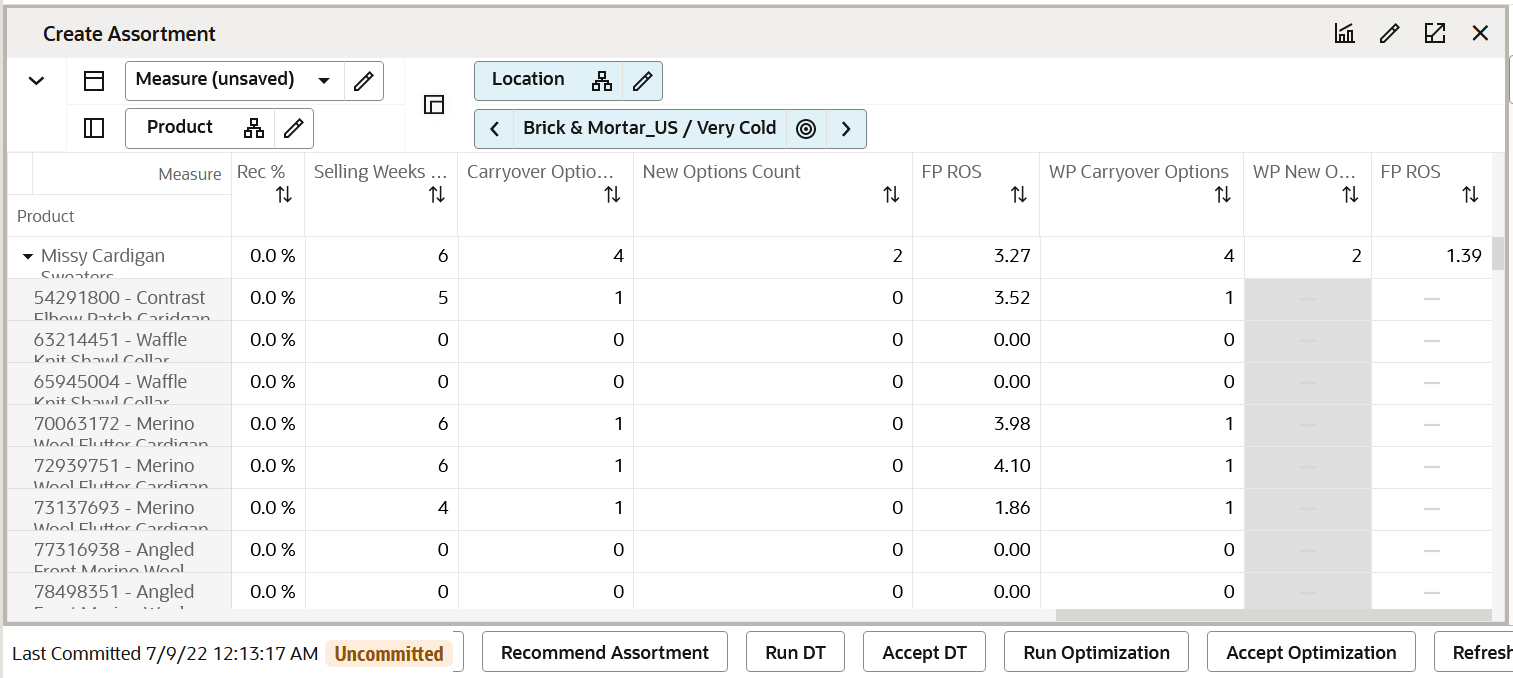
Measure Table
Table 9-15 Create Assortment View Measure
| Label | Definition |
|---|---|
|
Assorted Option |
Editable Boolean measure signifying if a particular option is assorted or not. |
|
Mandatory |
Boolean measure to mark a style-color as a mandatory option |
|
DT Recommended |
Read-Only Boolean measure marked as true if recommended by built-in AI Foundation engine |
|
Total Option count |
Total Option Count Assorted |
|
WP FP Total Option Count |
Target Total option count arrived at in the determine# of Steps |
|
Status |
Status of the item signifying if it is a New, Carryover, or a non-go forward item. |
|
WP Selling Start Week(Override) |
Beginning of selling cycle of the option |
|
Wp Selling End Week(Override) |
End of selling cycle of the option |
|
FR ROS Recommended |
Full Price weekly Rate of Sales Recommended. |
|
FP ROS |
Working Plan Full Price weekly Rate of sales. |
|
Sales Reg+Promo U Recommended |
Recommended Full Price Sales Units |
|
Sales Reg+Promo U |
Full Price Sales units. |
|
Sales Reg+Promo R |
Full Price Sales Retail. |
|
Selling Weeks |
Total number of weeks an option is planned to be sold |
|
Carryover Option Count |
Total number of carryover options |
|
New Options Count |
Total Number of new options |
Create Assortment - Visual View
The Create Assortment - Visual view is used to review the items for the shopping list visually and decide the best eligible candidates. You can view all of the available options and view the options (style/color) included in the shopping list. You can view the ranking of the options and add (Using +) in the card view of Available Options section to move the option to the shopped options section of the view. The Available Options section of the view contains the list of all Style/colors available for the Sub category, Assortment period, and Store Cluster.
You can also toggle between the different measure selections per card definitions and view the assortment visually per your needs to analyze the different measure values/attributes. You can also use attribute filtering/sort to view the style-colors of the attributes you want for analysis. You can also use Special filters and define/save attribute filters at once up to five attributes and their values. These saved filters can be applied in conjunction with the special filters that enhance the filtering.
You can remove (Using X) in the card view of shopped options section to move the option to the available options section of the view. There is also a summary section with an option to toggle between Total and To Target. When toggled for Total, the total options are compared to the target selected options. When toggled to the To Target, the selected options in the shopped options section are compared against the status of the options planned and shown accordingly.
A chart below shows the % of options selected in the shopped options to the targeted total options.
The steps to complete this process:
-
Select/modify/delete the options into/from the shopped options.
-
Select the card definitions to view the measures/attributes as needed for your analysis.
-
After any modifications, click the calculate action menu and review the summary of the data.
Figure 9-17 Create Assortment- Visual View
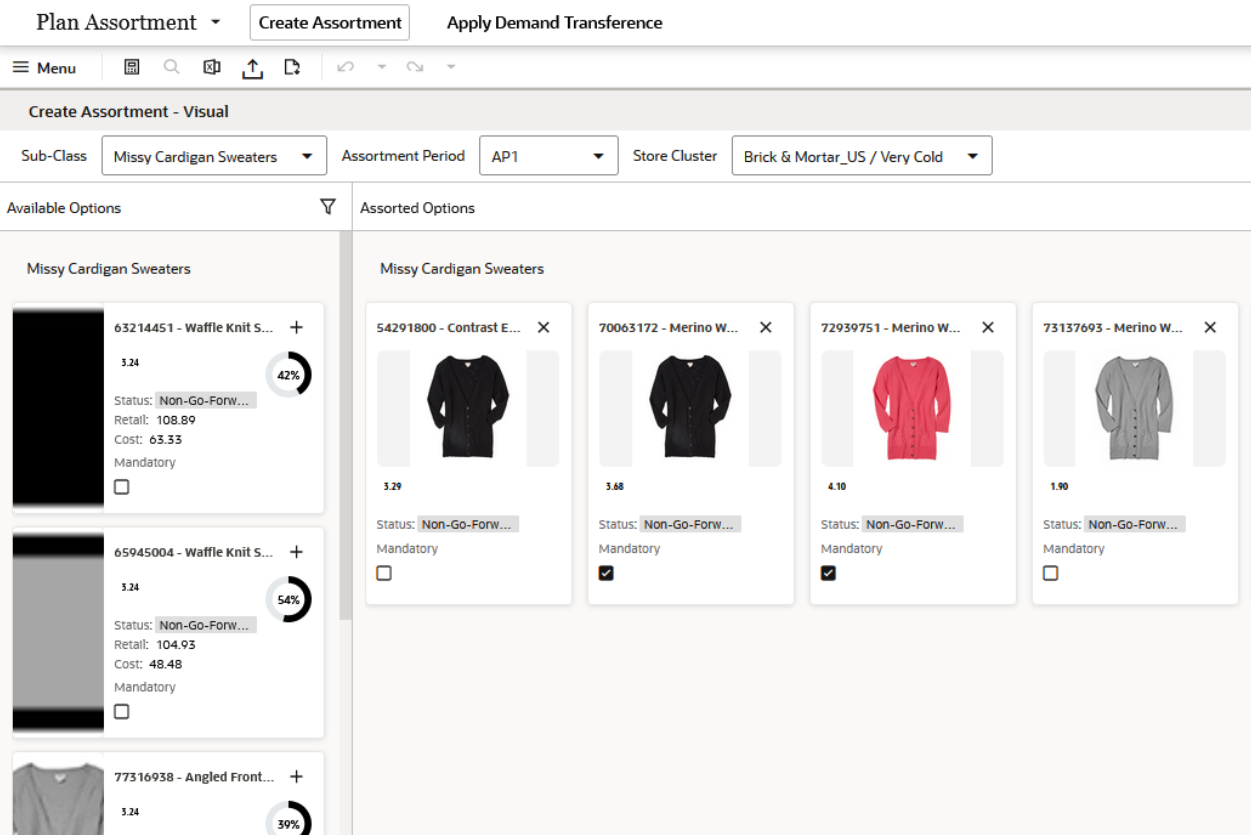
Measure Table
Table 9-16 Create Assortment - Visual View Measures
| Label | Definition |
|---|---|
|
Assorted Option |
Measure to select whether the option should be included in the working plan assortment. |
|
Available Option |
Measure to show all the available options. |
|
Status |
Auto-generated Status of the option selected. |
|
WP Option Rank |
Working Plan options ranking given to the style/color using the attribute ranking. |
|
Mandatory |
Boolean check box to indicate if the option is mandatory and to be included in the assortment. |
|
On Hand U |
On hand inventory units. |
|
New/carryover Options count |
The option count for new or carryover status. |
|
WP Total Option Count |
Working Plan Total options calculated at the Sub-class level or higher. |
|
New Options diff to Tgt +/- |
Difference of the new options considered to the targeted new options. |
|
Carryover Options diff to Tgt +/- |
Difference of the carryover options considered to the targeted carryover options. |
|
Total Options diff to Tgt +/- |
Difference of the total options considered to the targeted options. |
|
Tgt New/carryover/Max Options |
The working plan target new, carryover, and maximum options. |
|
New/Carryover/ WP Total Option Count |
The new, carryover, total options considered in the working plan. |
Define Product Rollup Tab
The Define Product Rollup Tab is used to quickly provide the planner with an ability to select product attributes as an alternate hierarchy. This is available in the tab to display the item level.
Define Product Rollup View
The Define Product Rollup view is used to select product attributes to view in an alternate hierarchy. This is available in the tab to display the item level.
Three groups of product attributes are provided with three levels in each group to enable nesting of plans by attributes that are important to the planner.
For example, for combination 1, you select Brand as Level 1, Color as Level 2, and Fabric as Level 3 by clicking the list of attributes available at that category. The planner will be able to review plans groups by brands, then grouped by color within each brand, and then by fabric within each color. If there are editable measures in the view, this feature allows you to view/edit subtotals at each nested level to spread the values to all the child positions.
This allows you to roll up your items by different attributes to analyze and review the proposed assortment based on important attributes. You may select up to three attributes at a time for one group for the nested dynamic rollup.
The steps to complete this process:
-
Select up to three levels of dynamic product attributes from the drop-down list.
-
Run the Refresh Product Rollup Application Action.
-
To view the product attribute:
-
In a view that displays item level, click the Product Hierarchy tile.
-
Select the attribute (Attribute 1, 2, or 3 level 1) that you would like to view in the dynamic rollup.
-
Click OK.
-
Figure 9-18 Define Product Rollup View

Measure Table
Table 9-17 Define Product Rollup View Measure
| Label | Definition |
|---|---|
|
Level 1, 2, 3 |
Drop-down list to present product attributes for nested dynamic product hierarchy rollup. |
Measure Profile
Default Profile
The Default profile is used to select dynamic product attributes.
Application Action
Refresh Product Rollup
The Refresh Product Rollup Application Action creates dynamically updated alternate hierarchies based on user-defined attribute selections. After running the application action, the user may select the alternate product hierarchy to see rollups based on the attribute selections.
Review Assortment Depth View
This view allows the planner to review the depth of assortments by reviewing the option count by product attributes of assorted options. Nested dynamic product rollup allows the planner to group and create subgroups allowing the planner to review metrics at the most granular product attribute level.
Figure 9-19 Review Assortment Depth View
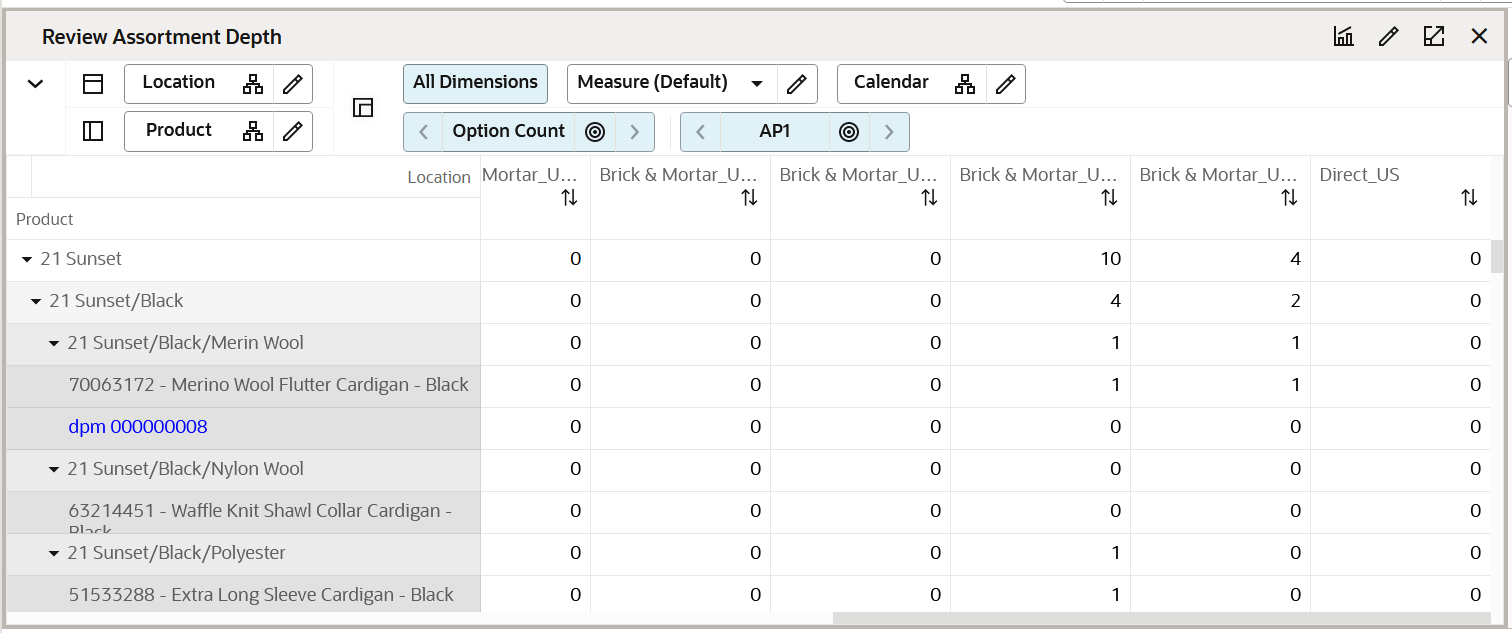
Measure Table
Table 9-18 Review Assortment Depth View Measure
| Label | Definition |
|---|---|
|
Option Count |
Total count of assorted options |
Time Phased Visual Assortment View
The Time Phased Visual Assortment view helps the buyer with a high-level view of the assortment at period level with visual images of style/colors. Once the buyer has created a style-color level assortment in the Wedge step, the Time Phased view step is used to review the assortment pictorially (in the form of product images). This facilitates an image-based review of the assortment plan being created, which can help to make a buyer's job more efficient. After reviewing the assortment at the style-color level in this view, the buyer can return to the Wedge step to make changes to the assortment, as per business requirements.
The style-color level assortment can be viewed at assortment period/cluster level. The Buyer can use the special filter to view the Visual Assortment.
The step to complete this process:
-
Review the Visual Assortment across the Time phase of Assortment Period.
Measure Table
Table 9-19 Time Phased Visual Assortment View Measure
| Label | Definition |
|---|---|
|
Visual Assortment |
Display the associated style/color image for the assigned flow weeks. |
Measure Profile
Default Profile
The Default profile is used to review the Visual Assortment for the assortment period and cluster.